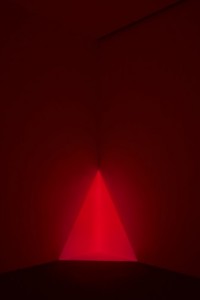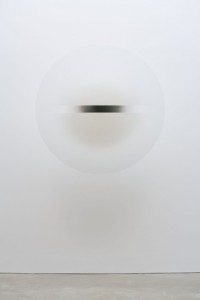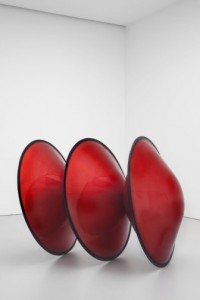Primary Atmospheres at David Zwirner
No smog here, at David Zwirner’s current show that is: “Primary Atmospheres: work from California 1960-1970”. The show itself is a kind of two-for dovetailing as it does with the preceding show of Dan Flavin’s work, who even though he was not a California artist always seemed as though he could have been. The gallery has even kept one of the Flavin’s in place to keep the visitors company, though sadly it is the least elegiac of that luscious grouping. The atmosphere of the current show title is surely that of primary colored plastic things and the shiny thoughts that might accompany them. Let me echo the gallery’s press release and evoke the works kindred spirit with the shiny resilient pleasures of custom painted surfboards or fetishized custom cars. That they did not include a screening of Kenneth Anger’s Kuston Kar Komandoes, –which hey was too made in 1960’s California– is a source of some regret.
And yet the work here is at its best when it is exactly those qualities of surface sheen and nothing-thereness that stun the viewer. The Taser effect, for example, of the first encounter with the two Turrel pieces, Juke green and Red Gard, (both 1968), is a moment of elation. They are pulled together from what are by now Turrell’s familiar sleights of hand, eye and light. And while there is no actual sculpture to trip over as you step forward to admire them it matters not because each empty wedge of light keeps pulling you forward emitting a tabernacle halo seducing its viewer in.
Robert Irwin’s, untitled (1969) dallies in this terrain so familiar to Turrell. Irwin’s object is truly seductive even as it comes to resemble a Milan designed surveillance apparatus. Irwin’s problem, at least when placed next to Turrell, is that his object can be demystified. You are lured in by much the same quasi-sacred glow as with Turrell. Yet when you get there, there is a there and it’s filled with stuff, you see and know how it all came about. Turrel keeps the Oz illusion going. Irwin seems like just an artist pulling Californian levers and buttons. His best grasp at evanescence comes in, Untitled (Acrylic Column) 1970-71. The work’s rigid plastic substance –through transparency, through lighting– does manage to all but disappear, quivering in and out of visibility like a malfunctioning holodeck.
Encounters with either artist’s work are not unlike the pleasure of a transfixing landscape. It might or might not be the landscapes of, say, Bierstadt I am thinking of, where the luminous openings of many a canyon in the Rockies endorse nature’s plenitude, and the viewers corresponding reflection of it. Yet I am more at ease comparing the work to a canny ‘take’ on landscape. Landscape when it is a distraction that kidnaps its viewer, and encapsulates her out of time, space or culture. In Godard’s Pierot le Fou there is a scene where the two outlaws on the run are traveling across a bluff near the ocean the camera, tracking at a distance, follows their journey. Abruptly without motivation by narrative or any logic internal to the film, Godard and the camera drift away and stare, distracted and transfixed on the breathtaking landscape across the Mediterranean. The fullness of the landscape turns ones head. Turns it away from narrative, from art. It is surely the long shot both Turrell and Irwin are going for, a competition between them and the plenary experience of nature or –back to that tabernacle– the sacred.
As a New Yorker I’ve never quite got the notion of what we might call automotive transcendence. De Wain Valentine’s Triple Disk Red Metal Flake – Black Edge (1966) is, in its weight and physical presence the piece in the show that most evokes the culture of cars and actual machine made objects. Much of the other work in the show can leave one a tad puzzled about provenance. We sorta, kinda know an artist made it in a studio. And we may suspect they had some nifty tech help. But Valentine’s large fiberglass sculpture looks like a piece of the Batmobile rolled out of George Barris’ shop. In the aforementioned Kenneth Anger film, nominally about custom car culture, there is an all too obvious chain of erotic displacements as the boys buff the rod. Valentines’ work marks a far different footprint. It really is a beautiful object that feels like it could skid into a parking spot in a corporate lobby at the drop of flag. Which is a disservice to
Valentine. He is never going to transgress in the rude (and frequently obvious) manner of Anger. Yet there are far more enigmatic pieces of his out there – resin disks and glass sculptures– that through working with the sea and sky (his claimed muses), and though owing to the power tool esthetic of surfers and custom car hounds set atmospheres abuzz with poetic ring tones.
Larry bell has earned his keep splitting, suturing and abrading our perceptive acts for four decades now. Here one of his signature mineral coated glass pieces keeps company with a selection of much smaller cubes. It is the smaller pieces that are the gems with facets to turn and refract object and viewer with each move. His shelf like, piece again untitled, (1970), made of vacuum coated glass poses a mirrored-like surface shimmering as if a disappearing horizon line. This is all perhaps the sunny frisson of California’s take on minimalism, blinded by the light in a way Judd would never have got until he hit Marfa. It is the quasi-conjuring aspect of much of this work that really takes your breath away. The now you see it, now you don’t of smoke and mirrors and trickster lighting. Catch it before it all disappears on February 6.
Through February 6, 2010
David Zwirner
533 West 19th street, New York, NY, 10001








